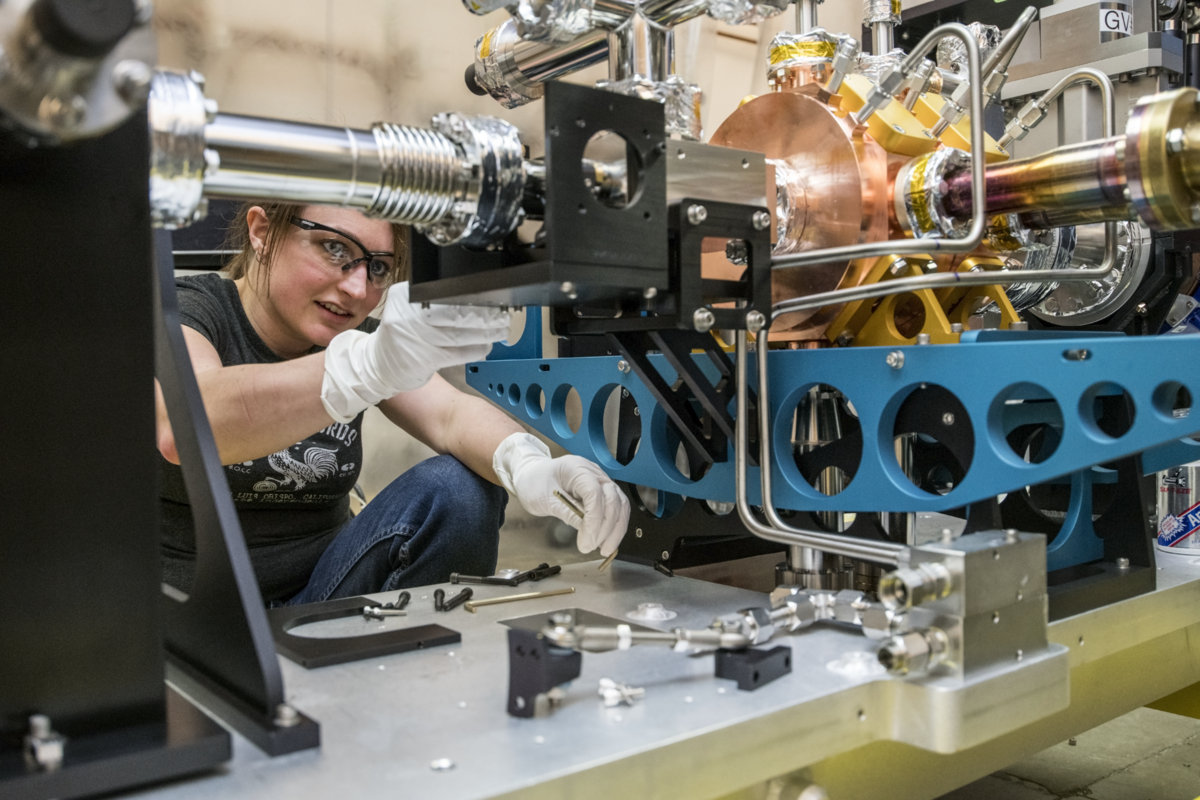DIRECTOR’S CORNER

ATAP’s mission, often in close partnership with the Engineering Division, includes contributing to some of the most challenging projects in the DOE research complex. In January, just a month after delivering a state-of-the-art magnet to the Facility for Rare Isotope Beams, ATAP had another milestone event: delivery of the injector source for Linac Coherent Light Source II.
Meanwhile, we’ve continued to advance the field and seek guidance for our future by organizing workshops. An ICFA Beam Dynamics Workshop held here in January focused on beam-beam effects in present and future circular colliders, and the LBNL-headquartered US Magnet Development Program met in February to review progress in its first full year and refine its course for the future. Further such meetings are being planned, including the inaugural workshop of the Berkeley Lab Accelerator Simulation Toolkit (BLAST) Program, to be held here in May.
Next-generation medical accelerators are among the promising spinoffs of our abilities. A pair of pre-meetings, which will lead to a fullfledged workshop, brought us together with UCSF and other partners in the quest to define a faciity for advanced particle-beam radiotherapy cancer treatment.
Finally, I’d like to bring everyone’s attention to opportunities to recognize the achievements of women in our Division and Lab, and to help guide and inspire the scientists of the future. I encourage all our employees to learn about these upcoming events and consider participating.
IT ALL STARTS WITH A ‘SPARK’: BERKELEY LAB DELIVERS INJECTOR THAT WILL DRIVE X-RAY LASER UPGRADE
Unique device will create bunches of electrons to stimulate million-per-second X-ray pulses
Every powerful X-ray pulse produced for experiments at a next-generation laser project, now under construction, will start with a “spark” — a burst of electrons emitted when a pulse of ultraviolet light strikes a 1-millimeter-wide spot on a specially coated surface.
A team at the U.S. Department of Energy’s Lawrence Berkeley National Laboratory (Berkeley Lab) designed and built a unique version of a device, called an injector gun, that can produce a steady stream of these electron bunches that will ultimately be used to produce brilliant X-ray laser pulses at a rapid-fire rate of up to 1 million per second.

Joe Wallig, left, a mechanical engineering associate, and Brian Reynolds, a mechanical technician, work on the final assembly of the LCLS-II injector gun in a specially designed clean room at Berkeley Lab in August. (Credit: Marilyn Chung/Berkeley Lab)
The injector arrived Jan. 22 at SLAC National Accelerator Laboratory (SLAC) in Menlo Park, California, the site of the Linac Coherent Light Source II (LCLS-II), an X-ray free-electron laser project.
Getting up to speed
The injector will be one of the first operating pieces of the new X-ray laser. Initial testing of the injector will begin shortly after its installation.
The injector will feed electron bunches into a superconducting particle accelerator that must be supercooled to extremely low temperatures to conduct electricity with nearly zero loss. The accelerated electron bunches will then be used to produce X-ray laser pulses.
Scientists will employ the X-ray pulses to explore the interaction of light and matter in new ways, producing sequences of snapshots that can create atomic- and molecular-scale “movies,” for example, to illuminate chemical changes, magnetic effects, and other phenomena that occur in just quadrillionths (million-billionths) of a second.
This new laser will complement experiments at SLAC’s existing X-ray laser, which launched in 2009 and fires up to 120 X-ray pulses per second. That laser will also be upgraded as a part of the LCLS-II project.
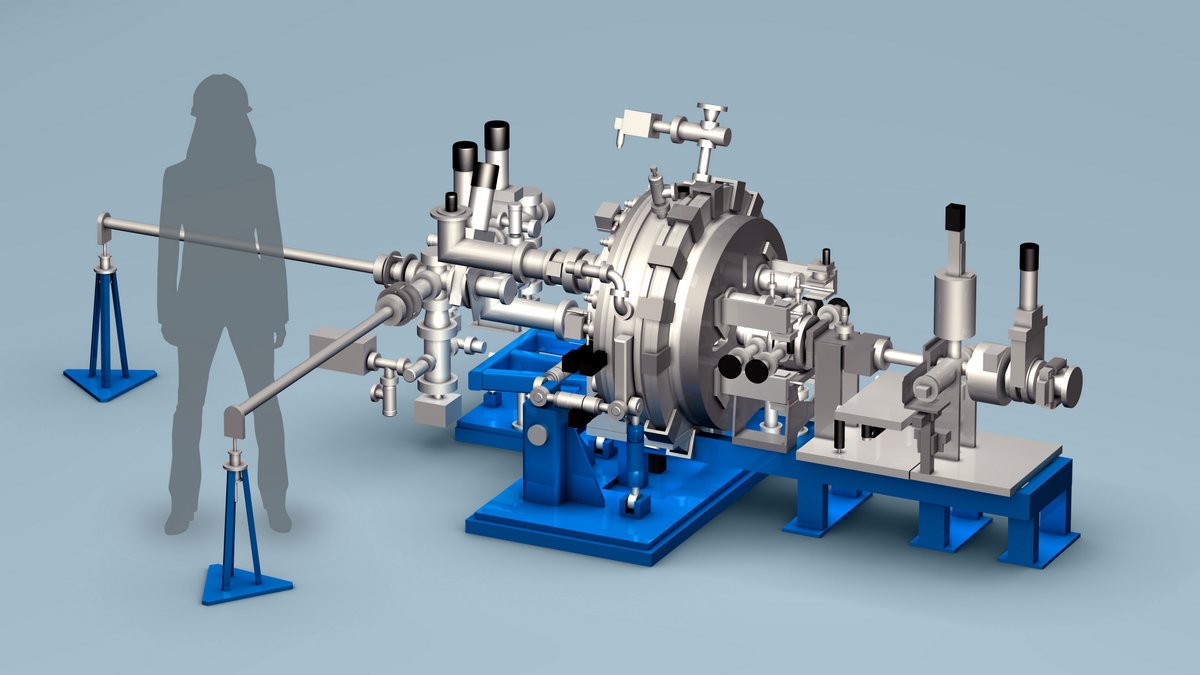
A rendering of the completed injector gun and related beam line equipment. (Credit: Greg Stewart/SLAC National Accelerator Laboratory)
The injector gun project teamed scientists from Berkeley Lab’s Accelerator Technology and Applied Physics Division with engineers and technologists from the Engineering Division in what Engineering Division Director Henrik von der Lippe described as “yet another success story from our longstanding partnership – (this was) a very challenging device to design and build.”
“The completion of the LCLS-II injector project is the culmination of more than three years of effort,” added Steve Virostek, a Berkeley Lab senior engineer who led the gun construction. The Berkeley Lab team included mechanical engineers, physicists, radio-frequency engineers, mechanical designers, fabrication shop personnel, and assembly technicians.
“Virtually everyone in the Lab’s main fabrication shop made vital contributions,” he added, in the areas of machining, welding, brazing, ultrahigh-vacuum cleaning, and precision measurements.
The injector source is one of Berkeley Lab’s major contributions to the LCLS-II project, and builds upon its expertise in similar electron gun designs, including the completion of a prototype gun. Almost a decade ago, Berkeley Lab researchers began building a prototype for the injector system in a beam-testing area at the Lab’s Advanced Light Source.
That successful effort, dubbed APEX (Advanced Photoinjector Experiment), produced a working injector that has since been repurposed for experiments that use its electron beam to study ultrafast processes at the atomic scale. Fernando Sannibale, Head of Accelerator Physics at the ALS, led the development of the prototype injector gun.
“We’re looking forward to continued collaboration with Berkeley Lab during commissioning of the gun,” said SLAC’s John Galayda, LCLS-II project director. “Though I am sure we will learn a lot during its first operation at SLAC, Berkeley Lab’s operating experience with APEX has put LCLS-II miles ahead on its way to achieving its performance and reliability objectives.”
Mike Dunne, LCLS director at SLAC, added, “The performance of the injector gun is a critical component that drives the overall operation of our X-ray laser facility, so we greatly look forward to seeing this system in operation at SLAC. The leap from 120 pulses per second to 1 million per second will be truly transformational for our science program.”
How it works
Like a battery, the injector has components called an anode and cathode. These components form a vacuum-sealed central copper chamber known as a radio-frequency accelerating cavity that sends out the electron bunches in a carefully controlled way.
The cavity is precisely tuned to operate at very high frequencies and is ringed with an array of channels that allow it to be water-cooled, preventing overheating from the radio-frequency currents interacting with copper in the injector’s central cavity.

A copper cone structure inside the injector gun’s central cavity. (Credit: Marilyn Chung/Berkeley Lab)
A copper cone structure within its central cavity is tipped with a specially coated and polished slug of molybdenum known as a photocathode. Light from an infrared laser is converted to an ultraviolet (UV) frequency laser, and this UV light is steered by mirrors onto a small spot on the cathode that is coated with cesium telluride (Cs2Te), exciting the electrons.
These electrons are are formed into bunches and accelerated by the cavity, which will, in turn, connect to the superconducting accelerator. After this electron beam is accelerated to nearly the speed of light, it will be wiggled within a series of powerful magnetic structures called undulator segments, stimulating the electrons to emit X-ray light that is delivered to experiments.
Precision engineering and spotless cleaning
Besides the precision engineering that was essential for the injector, Berkeley Lab researchers also developed processes for eliminating contaminants from components through a painstaking polishing process and by blasting them with dry ice pellets.
The final cleaning and assembly of the injector’s most critical components was performed in filtered-air clean rooms by employees wearing full-body protective clothing to further reduce contaminants — the highest-purity clean room used in the final assembly is actually housed within a larger clean room at Berkeley Lab.
“The superconducting linear accelerator is extremely sensitive to particulates,” such as dust and other types of tiny particles, Virostek said. “Its accelerating cells can become non-usable, so we had to go through quite a few iterations of planning to clean and assemble our system with as few particulates as possible.”
Even before the new injector is installed, Berkeley Lab has proposed to undertake a design study for a new injector that could generate electron bunches with more than double the output energy. This would enable higher-resolution X-ray-based images for certain types of experiments.
Berkeley Lab Contributions to LCLS-II
John Corlett, Berkeley Lab’s senior team leader, worked closely with the LCLS-II project managers at SLAC and with Berkeley Lab managers to bring the injector project to fruition.

Steve Virostek, a senior engineer who led the injector gun’s construction, inspects the mounted injector prior to shipment. (Credit: Marilyn Chung/Berkeley Lab)
“In addition to the injector source, Berkeley Lab is also responsible for the undulator segments for both of the LCLS-II X-ray free-electron laser beamlines, for the accelerator physics modeling that will optimize their performance, and for technical leadership in the low-level radio-frequency controls systems that stabilize the superconducting linear accelerator fields,” Corlett noted.
James Symons, Berkeley Lab’s associate director for physical sciences, said, “The LCLS-II project has provided a tremendous example of how multiple laboratories can bring together their complementary strengths to benefit the broader scientific community. The capabilities of LCLS-II will lead to transformational understanding of chemical reactions, and I’m proud of our ability to contribute to this important national project.”
LCLS-II is being built at SLAC with major technical contributions from Argonne National Laboratory, Fermilab, Jefferson Lab, Berkeley Lab, and Cornell University. Construction of LCLS-II is supported by DOE’s Office of Science.
View more photos of the injector gun and related equipment: here and here.
NEWS IN BRIEF
International Experts Gather at LBNL for Beam-Beam Effects Workshop
Beam-beam effects due to electromagnetic interactions of oppositely moving charged particles limit the performance of high-energy colliders. With a number of future machines, such as an electron-ion collider, under consideration, as well as upgrades such as the High-Luminosity LHC, experts on the subject gathered at LBNL February 5th through 7th 2018, for the Workshop on Beam-Beam Effects in Circular Colliders.
The workshop was hosted by ATAP and chaired by Dr. Ji Qiang of ATAP’s Accelerator Modeling Program (AMP), aided by an international organizing committee, with Martha Condon and Lucky Cortez of the ATAP operations team making local arrangements.

Each half day was a deep dive on a single topic, including Future Colliders, Beam-Beam Operational Experience, Coherent/Incoherent Beam-Beam interactions, Theory and Simulation, and Beam-Beam Compensation. The 35 participants shared operating experiences at existing machines, such as RHIC, LHC, BEPCII, and KEKB, and discussed future challenges and opportunities.
The LBNL workshop, held under the auspices of the International Committee on Future Accelerators (ICFA), followed up on similar events held at CERN in 1999, Fermilab in 2001, Montauk in 2003 and CERN in 2013. The subject is undergoing a recent revival of interest because the current state of modeling/simulation allows for much more detailed and accurate studies, leading to better predictions for future machines.
Although the types of colliders that were discussed differ significantly, they have many things in common and often face similar challenges. This broad applicability drew participants from throughout the accelerator community; besides Berkeley Lab, Brookhaven National Laboratory, CERN, École Polytechnique Fédérale de Lausanne, Fermilab, IHEP, Jefferson Laboratory, KEK, Michigan State University, Old Dominion University, and TRIUMF were represented.
To learn more…
· Visit the Indico site for the workshop
· Explore ATAP’s Accelerator Modeling Program
US-MDP Holds Second Annual Collaboration Meeting
 Thirty-seven experts on superconducting magnets and materials, representing three US national labs plus CERN, four universities, and three private-sector companies, convened in Jacksonville, Florida Feb. 8-10 for the second annual Collaboration Meeting of the US Magnet Development Program.
Thirty-seven experts on superconducting magnets and materials, representing three US national labs plus CERN, four universities, and three private-sector companies, convened in Jacksonville, Florida Feb. 8-10 for the second annual Collaboration Meeting of the US Magnet Development Program.
Sreela Sen, Martha Condon, and Joe Chew of the ATAP operations team helped organize the event.
In this second annual general meeting of the LBNL-headquartered, multi-institutional program, the primary purpose was to assess the state of current activities in cutting-edge conductor and magnet technologies, get a navigation fix on priorities, and discuss integration among the three member laboratories (LBNL, Fermilab, and the National High Magnetic Field Laboratory) and international collaborations.
The US-MDP Technical Advisory Committee, which attended the sessions and met at the end of each day, was impressed with the progress made on all fronts. Their recommendations included continuing and expanding cooperative work and management within the program as well as increasing the existing international cooperation.
To learn more…
· Read the Program Plan for the U.S. Magnet Development Program
· Visit the meeting’s Indico site
Workshop Pre-Meetings Explore Next Steps in Advanced Particle Therapy
Accelerator technology offers many prospects for highly targeted treatment of certain cancers, with potential advantages in effectiveness and sparing of healthy tissues compared to other treatment modalities. To explore these possibilities, a pair of Advanced Particle Therapy Facility Workshop Pre-Meetings — a technology-focused one on December 20, 2017 at LBNL and a clinically-oriented one February 22 at the University of California, San Francisco — brought together experts in accelerators, modeling, instrumentation, biophysics, and research and clinical medicine, primarily from LBNL, UCSF, and the University of California, Davis.
 “Bragg peak” of energy deposition is key principle of proton and heavy-ion therapy |
The therapeutic use of heavy ion beams, precisely aimed at a cancer from outside the body, was pioneered with research and clinical trials at Berkeley Lab’s 184-Inch Synchrocyclotron and the Bevalac. Today, heavy-ion charged particle therapy stands to benefit from the synergy of cutting-edge innovations in which ATAP and kindred LBNL organizations can contribute.
In another exciting prospective application of LBNL capbilities, “electron brachytherapy” could use a laser-plasma accelerator so miniaturized that it can be inserted into the body to generate precision-targeted electron radiation at the exact site where it is needed. |
|
Both heavy-ion radiotherapy and electron brachytherapy would be outstanding leverage of the existing DOE Office of High Energy Physics investment in the underlying technologies and capabilities, including next-generation accelerators, beam-delivery gantries, instrumentation, and computer modeling. A facility that is far more compact than those of today and offers the best possible patient treatment is one of the long-term goals of the pre-meetings and a follow-on workshop that is now being planned.
Such a facility may be based on a laer-plasma accelerator; BELLA has in fact successfully accelerated ions in early experiments, and is planning further development of this capability, with the goal of a user facility called BELLA-i. This capability could become the heart of a much more compact approach to heavy-ion therapy, compared to large conventional accelerators.
LBNL contributions and interest come from the biomedical side as well. In the decades since the 184-Inch and Bevalac were decommissioned, LBNL has continued its tradition of radiation biology research. Meanwhile, in the worldwide picture, charged-particle therapy has continued to grow in sophistication, and developments that could be summarized as individually tailored “precision medicine” play into a grand synergy of capabilities.

February 22, 2018 UCSF Pre-Meeting attendees. Click for larger version.
The LBNL pre-meeting was supported through the Berkeley Lab Foundation.
The pre-meetings were organized by Drs. Wim Leemans and Ellie Blakely of LBNL, Drs. Mack Roach III, M.D., Bruce Faddegon, and Ann Lazar of UCSF, and Dr. Reinhard Schlute, M.D., of Loma Linda University. The events fostered a lively dialogue, and now, a fullfledged workshop is being planned that will define challenges and opportunities in four main areas:
· Fundamental relevant challenges in radiation biology, biophysics, and medical physics
· Novel technologies in accelerators, beam manipulation and delivery, and precision realtime detectors that could transform particle beam therapy.
· The next steps in defining a national particle-therapy research facility.
· Work that can be done with present facilities to inform these decisions and clinically justify the facility.
It is unquestionable that heavy ions are useful for radiotherapy; the need is for rigorous clinical evidence that long-term patient outcomes are sufficiently better to justify the investment in a research facility and eventual clinical facilities. The potential of electron brachytherapy also had participants excited and could become one of the first real-world applications of LPA technology.
Berkeley Lab expertise has many other potential radiation therapy contributions as well. Improved “gantries” that deliver proton or heavy-ion beams to the patient are being developed by ATAP and Engineering’s Berkeley Center for Magnet Technology in cooperation with private-sector partner Varian and the Swiss national laboratory Paul Scherrer Institute. Berkeley Lab’s advanced capabilities in radiation detectors could help with the need to precisely control the placement and amount of treatment fractions in real time even as the patient breathes and moves. Watch these pages for more on these topics in the months to come.
EDUCATION AND OUTREACH
Daughters and Sons to Work Day, Nuclear Science Day for Scouts Highlight Upcoming Outreach OpportunitiesTwo spring traditions at the Lab are coming up soon: Daughters and Sons to Work Day (Wednesday, April 18) and Nuclear Science Day for Scouts (Saturday, May 5). Volunteers make both events possible, and you don’t need to be a scientist or engineer to help, so whatever you do, come share what you find rewarding about it and help build the people who will build the future. Maybe the winner of the 2050 Nobel Prize in Physics will name-check you as an early inspiration! |
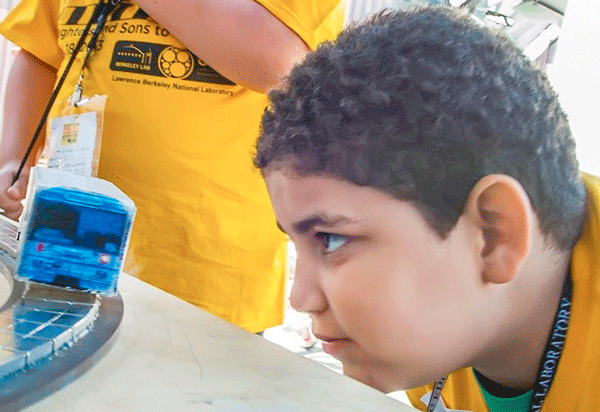 Maglev model train is a perennial favorite among the interactive demos |
|
Wednesday, April 18: Daughters and Sons to Work Day
This Labwide event allows Lab employees to bring their children or grandchildren, age 9 or older, onsite to see firsthand what we do. They will tour LBNL facilities and experience hands-on science experiments. Programs appropriate for various age groups are available. There is a modest fee covering the T-shirts, lunch and some of the materials. To sign up children, watch for a Today at Berkeley Lab announcement giving details, or visit the D&STW website.
D&STW Volunteer Opportunities
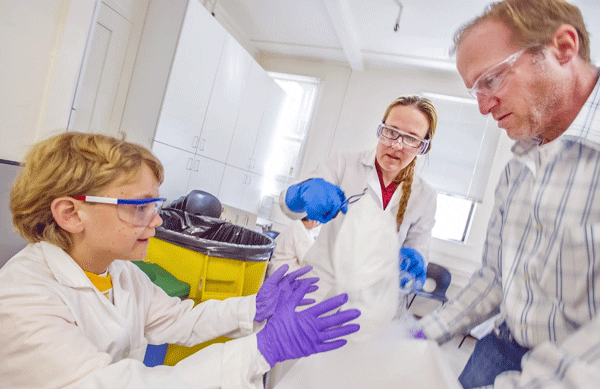 ATAP’s Ina Reichel (center) and Dan Dietderich pass cryogenics knowledge to eager and properly protected young hands |
The liquid nitrogen workshops run by ATAP’s Outreach and Education Coordinator, Dr. Ina Reichel, are among the most popular D&STW events, and we need several adult volunteers for supervision and to help with handing out materials.
No experience is needed. Cryogen Safety (EHS0170, an online course that takes about 30 minutes) is recommended though not required, and people who have done this before will be on hand for guidance. The workshop is a lot of fun, and at the grand finale, if you can compete with 30 excited small children for ice cream made with the aid of liquid nitrogen, you’ll even get a unique snack! If you would like to help with one of the three 75-minute workshops or with prepping materials in the morning, please contact Ina Reichel (IReichel@lbl.gov). |
|
To learn about other volunteer roles, such as registration, monitoring lunch, or helping with other activities, please contact Mara Lockowandt (MLockowandt@lbl.gov).
You can sign up your own child and be a volunteer.
A Scout Is Trustworthy, Loyal, Helpful, and Informed about Synchrotron Light:
Nuclear Science Day for Scouts, Saturday, May 5
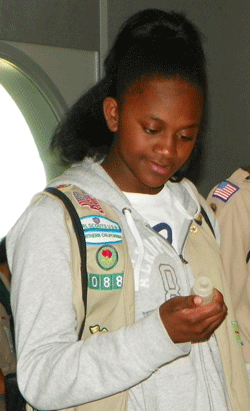 Preparing for a hands-on demo |
On Saturday, May 5th the Nuclear Science Division, ATAP, and the Workforce Development and Education Office are co-hosting another annual tradition: Nuclear Science Day for Scouts. The event brings some 180-200 Boy and Girl Scouts to the Lab as part of earning a nuclear science merit badge.
Volunteers are needed for such tasks as registration in the morning, assistance with workshops, a career panel, and chaperoning groups from one activity to the next, where local experts will show them around and answer their questions. Tours of the Advanced Light Source are always a highlight, so the organizers are especially looking for tour guides who work at that facility. Volunteers can sign up at the Nuclear Science Day website. If you work at the ALS and are interested in being a tour guide there, please also contact Ina Reichel (IReichel@lbl.gov). If you are a Scout leader who would like to sign up your troop, watch the Nuclear Science Day website for more information that will be posted soon. |
|
WORKPLACE LIFE
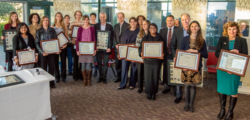 Do you know someone who should join these previous honorees? |
Women @ The Lab Honors: Nomination Deadline March 9Extending DOE’s “Women @ Energy” initiative here at Berkeley Lab, the Women Scientists and Engineers Council (WSEC) and the Diversity, Equity, and Inclusion (DEI) Office are excited to host the third Women @ The Lab event in June. We seek nominations for talented and dedicated women employees across Berkeley Lab whose achievements and contributions to the Lab’s mission merit recognition. The deadline is March 9. |
Support staff in technical and administrative/operations roles, as well as scientists and engineers, are eligible.
If you know a woman in or working with ATAP (or elsewhere at Berkeley Lab) whom you would like to nominate, by all means do so. ATAP Outreach and Education Coordinator Ina Reichel (IReichel@lbl.gov) extends an offer of help if you would like.
To learn more and download the nomination form, visit the DEI Office’s Women @ The Lab 2018 page.
SAFETY: THE BOTTOM LINE
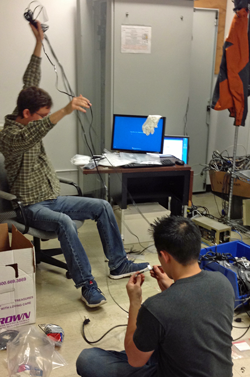 Reorganizing a computer room at Safety Day 2017 |
Mark Your Calendars for Tuesday, August 21: Physical Sciences Area Safety DayWith safety as a top priority in the Physical Sciences Area, Safety Day is becoming an annual tradition. This all-hands, all-hazards, all-day event has a mission of “Clean Labs, Clean Shops, Clean Offices,” reflecting a primary emphasis on good housekeeping and identification of hazards in common areas, offices, labs, and shops. Things that we can take care of immediately (and safely, staying within our skill sets) we will fix on the spot. Problems that are not feasible to fix immediately, and larger-scale suggestions that call for time and money and planning, will be officially noted and scheduled for later action. You can also dedicate part of the day to reviewing your WPC Activities or getting caught up on training. We’ll be back in touch with further details and will post resources on our website. Meanwhile, please block out August 21 on your calendar and plan on being part of the communal investment in safe and efficient work environments. |
|
